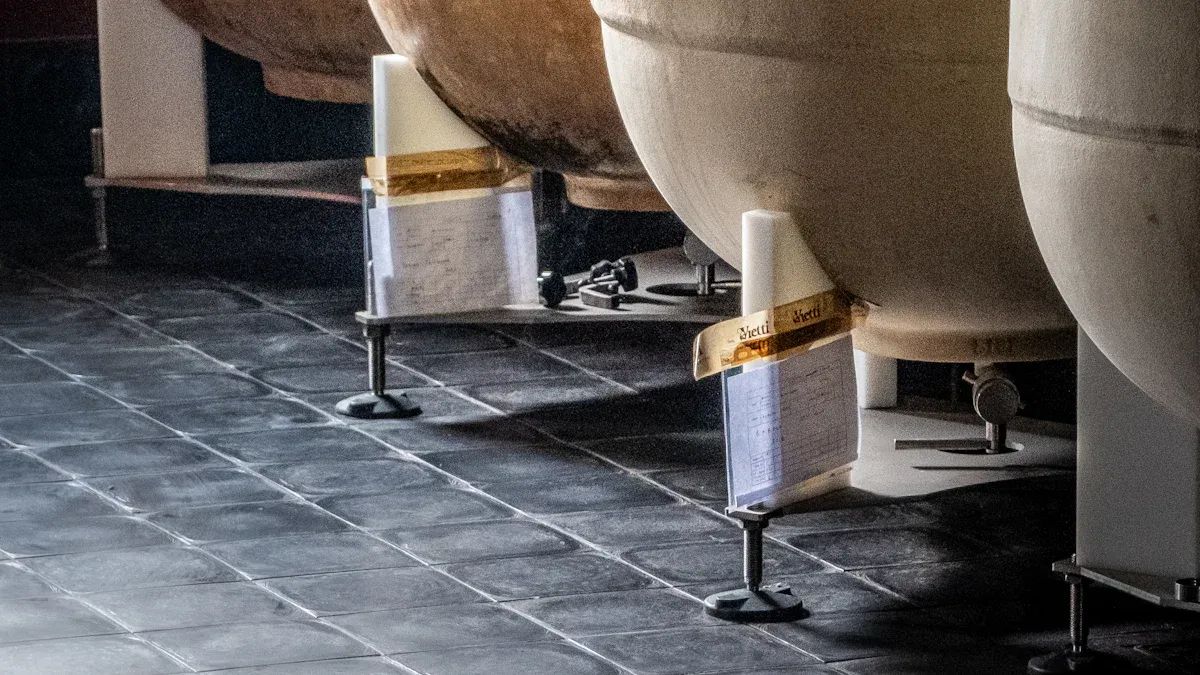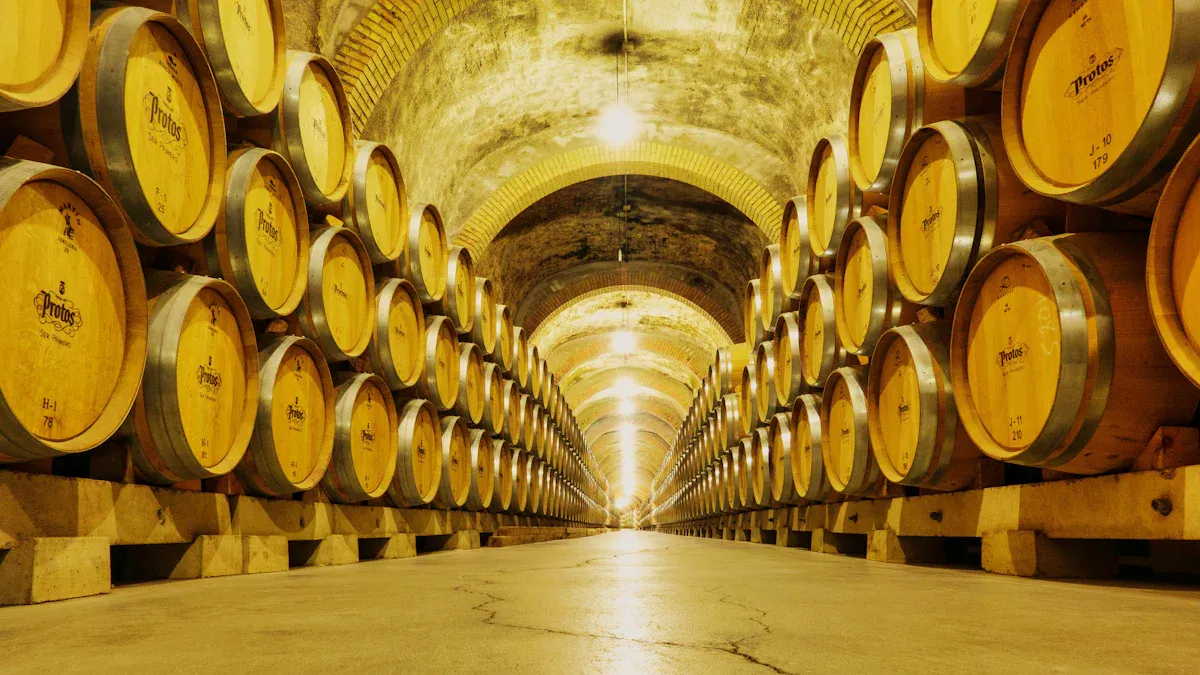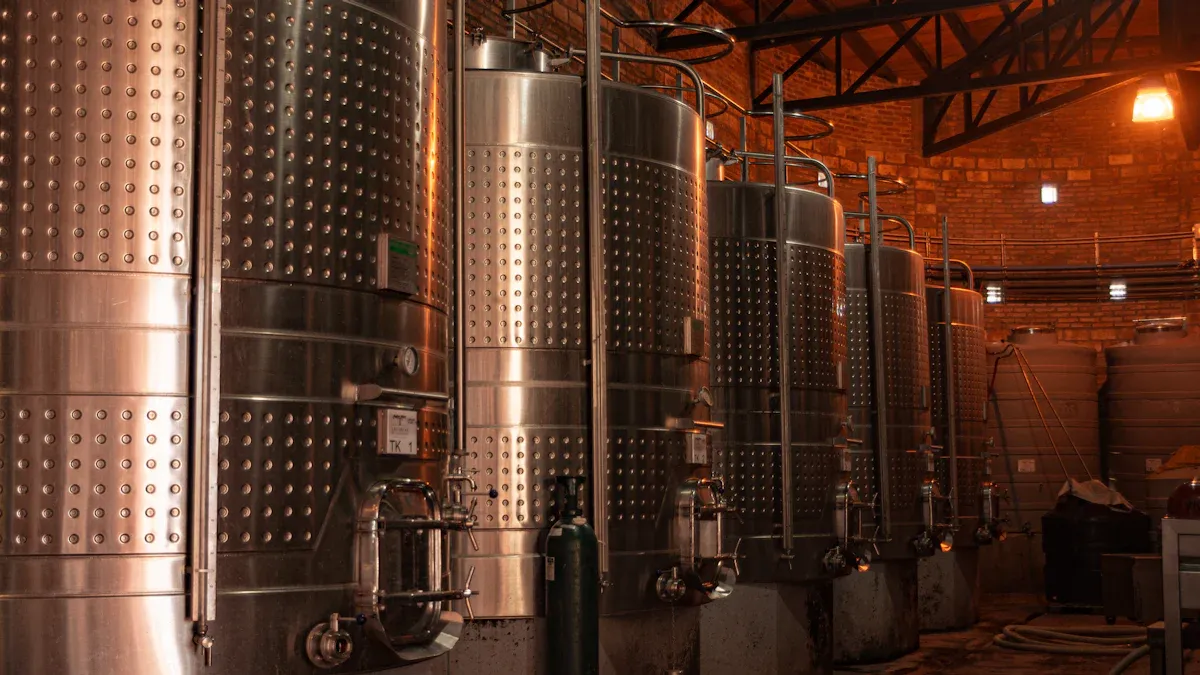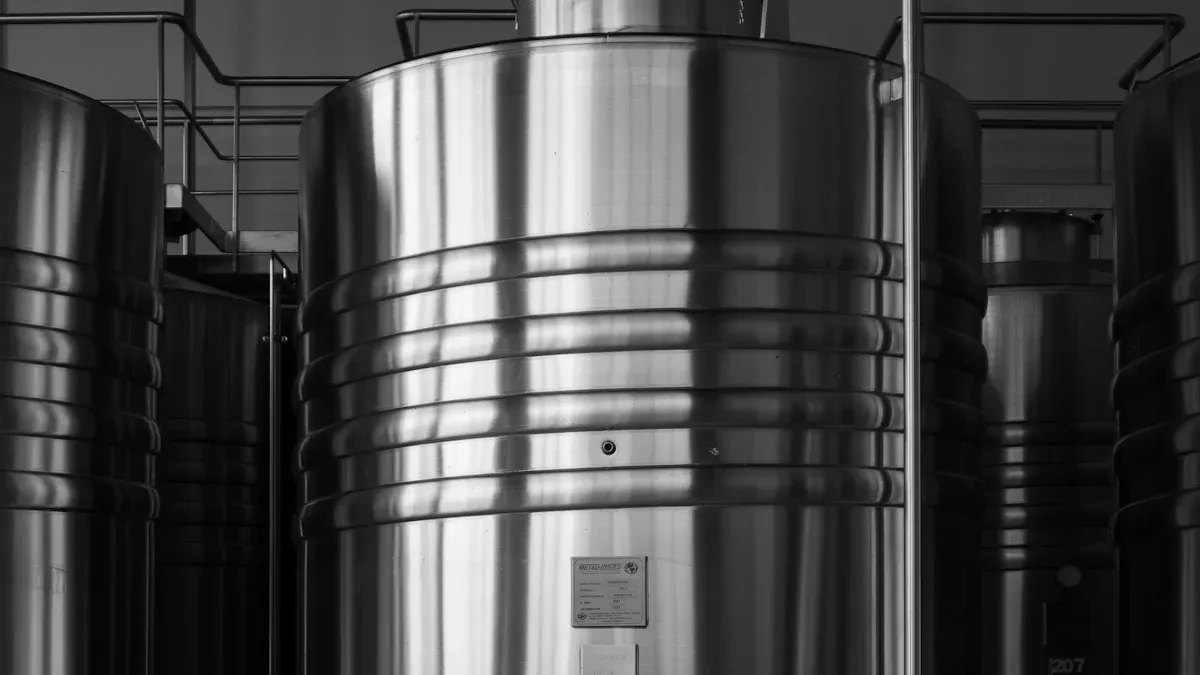
The material you choose for a wine fermentation container shapes both the flavor and quality of your wine. Stainless steel, concrete, and oak barrels stand out as the most common materials for fermentation and maturation. Each material changes how much oxygen reaches the wine, which affects the final flavor. For example, studies show that concrete and claystone allow different levels of oxygen exposure, which you can control through coatings or treatments. Temperature control also depends on the container’s material, making it easier or harder to manage fermentation. Choosing the right wine fermentation tank gives you more control over the flavor and quality of your wine.
Chenma is one of the professional stainless steel wine tank manufacturers that can provide wineries with a variety of solutions. We also provide cider tank、stainless steel oil tank, ect.
Stainless Steel Wine Fermentation Containers
Flavor and Aroma Effects
When you use a stainless steel wine fermentation container, you help preserve the true flavors and aromas of your wine. Studies show that stainless-steel fermenters do not add extra compounds to the wine. Instead, they keep the original floral, fruity, and herbal aromas strong. For example, Merlot wines fermented in stainless steel tanks keep their fresh and clean flavor. You do not get smoky or woody notes, which often come from oak barrels. Stainless steel fermentation tanks also limit the amount of phenolic and wood-derived compounds in your wine. This means you can taste the grape’s natural flavors without outside influence. The material does not react with the wine, so you get a pure and consistent flavor profile every time.
Advantages
Stainless steel wine fermentation tanks offer many benefits for both new and experienced winemakers:
- You can control fermentation temperature very precisely, which helps yeast work at its best and improves wine quality.
- The airtight design lets you manage oxygen exposure, which prevents off-flavors and keeps the wine’s true character.
- Smooth, non-porous surfaces make cleaning easy and fast. For example, cleaning time can drop from 45 to just 6 minutes per tank, saving you time and money.
- Stainless-steel fermenters prevent contamination and keep unwanted elements out of your wine.
- Advanced tanks allow real-time monitoring and automatic adjustments, so you can make different wine styles with confidence.
Chenma stands out in this field. The company uses advanced manufacturing and strict quality standards. You can trust their wine fermentation tanks because they meet ISO9001, ISO14001, OHSAS18001, and EU CE certifications. Their engineers can also customize tanks to fit your needs, making them a top choice for quality and safety.
Disadvantages
| Disadvantage / Limitation | Explanation |
|---|---|
| Higher Initial Cost Compared to Other Materials | Stainless steel tanks require a significant upfront investment compared to plastic or oak, which may deter new winemakers. However, they offer long-term durability and low maintenance costs. |
| Limited Oxygen Interaction for Certain Wine Styles | The airtight nature of stainless steel limits oxygen exposure, which can negatively affect red wines like Cabernet Sauvignon or Merlot that benefit from oxygen during fermentation to soften tannins and enhance complexity. |
| Potential for Over-Sanitization Impacting Wine Character | The ease of cleaning stainless steel can lead to over-sanitization, stripping away natural yeast and bacteria that contribute to wine’s unique character, potentially resulting in wines that taste too sterile or lack depth. |
Best Uses
You should choose stainless steel fermentation tanks wine for many types of wine, especially when you want to highlight fresh flavors and aromas. These tanks work best for white wines, rosé, and sparkling wines, where you want to keep the original grape character. Stainless-steel fermenters also suit large production runs and experimental batches. You can adjust tank size and number based on your production volume. For example, if you produce 4,000 liters of wine per month in 1,000-liter batches, you need at least four tanks. Overlapping fermentation cycles help you use your tanks efficiently. Stainless steel wine fermentation tanks give you flexibility, control, and high quality, making them a smart choice for many winemakers.
Oak Wine Fermentation Vessels

Flavor Impact
When you use oak as a wine fermentation container, you create unique flavor profiles that stand out. Oak wood tanks, including barrique and foudre, add special flavors and aromas to wine. The material of the vessel matters a lot. Oak species, where the wood comes from, and how it is toasted all change the impact on wine flavor. You can taste vanilla, coconut, clove, nutmeg, cinnamon, toast, smoke, and spice in wines fermented in oak barrels. French oak gives subtle flavors and less oxygen, which helps you make elegant wines. American oak adds stronger flavors and more oxygen, making bold wines. The size and shape of the vessel, like a barrique or a foudre, also affect how much skin contact and oxygen the wine gets. This changes the expression and quality of the final product. Oak fermentation helps with malolactic fermentation, giving wine a creamy mouthfeel and balancing freshness and acidity.
Tip: The longer wine stays in oak, the more flavor complexity and aroma it gains. You can control this by choosing the right type of oak and how long you let the wine ferment.
Pros
- Oak wood tanks allow gentle oxygen exposure, which helps soften tannins and improve quality.
- You get unique flavor profiles, such as vanilla, spice, and toast, that make your wine stand out.
- Oak vessels support malolactic fermentation, which adds creaminess and smoothness.
- Using different types of oak, like French or American, lets you control the style and flavor complexity of your wine.
- Barrique and foudre shapes give you options for different wine styles and levels of extraction.
Cons
| Limitation/Drawback | Explanation |
|---|---|
| High cost of barrels | Oak barrels and foudres are expensive compared to other materials. |
| Variability in wood properties | Each piece of wood is different, so flavor and quality can change from barrel to barrel. |
| Risk of excessive wood flavors | Too much oak or improper use can overpower wine with wood aromas and mask fruitiness. |
| Environmental impact | Making barrels uses a lot of resources and affects the environment. |
| Complex manufacturing process | Toasting and seasoning the wood adds extra steps and can change the final wine flavor. |
| Incomplete understanding | Scientists do not fully understand how oak changes wine, so results can be hard to predict. |
Ideal Applications
You should use oak fermentation vessels when you want to add flavor complexity and create unique flavor profiles in your wine. Oak works best for red wines that need structure and depth, such as Cabernet Sauvignon or Syrah. You can also use barrique for smaller batches and foudre for larger volumes. Oak helps you make wines with rich aromas, creamy texture, and balanced freshness. If you want to highlight the impact on wine flavor and improve quality, oak is a classic choice for both traditional and modern winemaking.
Concrete Fermentation Vessels
Influence on Wine Flavor
Concrete fermentation tanks wine offer a unique way to shape the flavor and quality of your wine. When you use this material as your wine fermentation container, you combine the best features of oak and stainless steel. Concrete tanks do not add extra flavors like oak, but they allow gentle oxygen exposure through their porous walls. This micro-oxygenation softens tannins and helps balance the wine’s mouthfeel. For example, the Lalomba winery found that concrete tanks preserved fruit character and freshness while creating a juicier texture. Oxygen levels in concrete are about half those in oak, which influences malolactic fermentation and the final flavor balance. The composition of the concrete, such as the type of sand or stone, can even add a subtle mineral note, giving your wine a sense of place.
| Vessel Type | Material | Flavor Influence | Advantages | Disadvantages |
|---|---|---|---|---|
| Oak Barrels | Oak wood | Imparts vanilla, spice, tannins | Micro-oxygenation, tradition | Costly, requires upkeep |
| Stainless Steel | Stainless steel | Clean, pure, fruit-forward | Precise temperature control, inert | Limited oxygen exchange |
| Concrete Tanks | Concrete | Adds minerality, texture | Thermal stability, gentle oxygenation | Heavy, porous |
Benefits
You gain several advantages when you choose concrete tanks for fermentation. Concrete’s thick walls, often up to 5 inches, absorb and slowly release heat. This thermal stability keeps fermentation temperatures steady, which protects wine quality and supports healthy yeast activity. Concrete tanks wine allow for longer, cooler fermentations that enhance color, flavor, and tannin extraction. The shape of these tanks, such as egg or cone designs, helps natural circulation and keeps the lees moving, which boosts complexity and texture. Concrete’s gentle oxygenation supports balanced fermentation and improves the overall quality of your wine.
Tip: Concrete tanks come in many sizes, from small amphorae to large vessels holding up to 38,000 liters. You can match the tank size to your production needs.
Drawbacks
You should know about some challenges with concrete fermentation tanks wine. Scientific studies highlight these drawbacks:
- Concrete tanks are heavy and difficult to move or install.
- Porous surfaces can develop cracks or leaks if not maintained.
- Long-term use may lead to material degradation, reducing strength and safety.
- Improper inspection or handling can cause failures, especially after physical damage.
- Leaks may occur if the structure loses tightness.
- Repairs often require removing damaged layers and applying reinforced coatings.
- Human error and lack of technical awareness can increase risks.
When to Use
You should use concrete fermentation tanks wine when you want to control temperature and achieve a pure, balanced flavor. These tanks work best for wines where you want to highlight fruit character and texture without adding outside flavors. Concrete’s thermal mass supports stable, cool fermentations, which improve color and tannin extraction. If you produce wine at a larger scale, you can choose from a range of tank sizes to fit your needs. Egg-shaped or cone-shaped tanks help with natural mixing, making your wine more complex. Concrete is a smart choice when you value quality, flavor balance, and a sense of place in your wine.
Clay and Amphorae Fermentation Vessels

Flavor Profile
When you choose clay or amphorae vessels for wine fermentation, you unlock unique flavor profiles that stand apart from other methods. Clay is a porous material. It allows gentle oxygen exchange during fermentation. This process softens the wine and adds texture and complexity. Unlike wood, clay does not add its own flavors. Instead, it lets the grape’s true character shine. Modern winemakers often use amphorae to create wines with a distinct expression. You may notice more minerality, floral notes, and a round mouthfeel. For example, wines like the 2019 Vitalba Secco Albana show ripe stone fruit, ginger, and toasted hazelnut after 90 days in amphora. The 2018 Luccianus Amphore from Bordeaux displays black fruits and dense tannins, showing how this vessel shapes flavor.
Note: Clay amphorae allow a delicate oxygen exchange that influences chemical reactions during aging, softening tannins and enhancing complexity. This results in flavors and aromas you cannot achieve with stainless steel or wood alone.
Strengths
- Clay vessels give you a neutral base, so the grape’s natural flavor stands out.
- The slow oxygen exchange helps soften tannins and build complexity.
- Amphorae support a stable fermentation temperature, which protects wine quality.
- You can create wines with unique flavor profiles that highlight terroir and grape variety.
Limitations
Scientific research shows some limits when you use clay and amphorae for wine fermentation. The oxygen flow depends on how the vessel was made, so results can vary. You may find that commercial yeast strains do not always work well in these vessels. Indigenous yeast often adapts better to the clay environment. The porous material can also affect the wine’s polyphenolic and aromatic profile in ways that are not fully understood. Traditional methods, like those in Portugal, use pine pitch coatings and long contact with grape skins. These methods can change the wine’s shelf life and flavor. There is still a lack of scientific data on how these vessels affect fermentation and aging, so you may need to experiment to get the best results.
Suitable Wines
You should use clay and amphorae vessels when you want to make wines that express their origin and grape variety. These vessels work well for both white and red wines. For example, Pinot Noir, Albana, and Aglianico all show unique flavor profiles when fermented in amphorae. If you want to highlight minerality, floral notes, or a round texture, clay is a strong choice. You can also use these vessels to create natural or low-intervention wines, where the material supports a pure and honest expression of the grape.
Plastic and Glass Fermentation Containers
Flavor Considerations
When you use plastic or glass containers for wine fermentation, you can expect subtle differences in flavor. Scientific studies show that most people find only minor flavor changes between plastic and glass vessels. Some tasters notice slight differences, but these are not always linked directly to the container material. Factors like plastic aging or surface scratches may play a role. In other foods, such as Sichuan pickles, plastic jars can change the flavor profile more than glass. Plastic may lead to higher acid levels and different microbes, which can affect the final flavor of your wine. Glass, on the other hand, does not react with the wine and keeps the flavors pure.
Advantages
Plastic and glass containers offer several benefits for wine fermentation:
- Plastic buckets are lightweight and easy to move. You can clean them quickly and use them for short-term fermentation.
- Glass carboys keep oxygen out, which helps preserve the wine’s flavor and quality.
- Both materials are affordable and easy to find. You can start small batches of wine without a big investment.
- Glass containers allow you to see the fermentation process, making it easier to monitor changes.
Tip: Use glass containers if you want to keep the wine’s flavors pure and avoid unwanted reactions.
Disadvantages
You should know about some drawbacks when using these materials for wine fermentation.
- Glass containers break easily. This can be dangerous, especially if you have children at home.
- Plastic containers can scratch over time. Scratches may hold bacteria and affect the flavor of your wine.
- Plastic is best for short-term fermentation. It is not recommended for aging wine because the material may degrade and change the flavor.
- Glass carboys are heavy and hard to handle, especially when full.
| Container Type | Main Disadvantage | Impact on Wine Fermentation |
|---|---|---|
| Glass | Fragility, heavy to handle | Risk of breakage, safety concerns |
| Plastic | Scratches, not for long-term use | Possible flavor changes, hygiene |
Best Scenarios
You should use plastic containers for primary fermentation or when making small batches of wine. They work well if you plan to transfer the wine to another vessel for aging. Glass containers are best when you want to keep the wine’s flavor pure and avoid any reaction with the material. Glass works well for both fermentation and storage, especially if you want to watch the process. If you need rapid fermentation and want to encourage lactic acid bacteria, glass can help. For long-term aging, choose glass over plastic to protect the wine’s flavor and quality.
Comparing Fermentation Vessels
Key Differences
When you compare wine fermentation vessels, you see that each material shapes the wine’s flavor, quality, and aromas in unique ways. Your choice of vessel affects how much oxygen reaches the wine, how well you can control temperature, and how easy it is to clean and maintain the equipment. The following table gives you a clear overview of the main differences among common materials:
| Material | Durability | Ease of Cleaning | Temperature Control | Flavor Impact | Cost |
|---|---|---|---|---|---|
| Stainless Steel | High | Easy | Excellent | None | High |
| Concrete | Medium | Moderate | Good | None | Medium |
| Wood (Oak) | Medium | Difficult | Moderate | Adds Complexity | High |
| Polyethylene | Low | Easy | Limited | None | Low |
| Amphorae (Clay) | Low | Moderate | Moderate | Unique Profiles | High |
You notice that stainless steel tanks stand out for their durability and precise temperature control. They do not add any flavor, so you get varietal purity and a clean taste. Concrete tanks offer good temperature stability and allow gentle oxygen exposure, which helps with fermentation and texture but does not change the wine’s flavor. Oak barrels, including barrique and foudre, add complexity and distinct flavors like vanilla or spice. These vessels require more care and cleaning. Polyethylene tanks are affordable and easy to use for small batches, but they do not last as long and offer limited temperature control. Amphorae, made from clay, create unique flavor profiles and support gentle oxygen exchange, but they cost more and can be fragile.
Tip: If you want to focus on quality and consistency, stainless steel and concrete tanks give you more control. If you want to add complexity and traditional character, oak and amphorae offer special advantages.
Matching to Wine Styles
You can match the material of your fermentation vessel to the style of wine you want to create. Each vessel supports different goals for flavor, quality, and fermentation dynamics. For crisp white wines or sparkling wines, stainless steel tanks help you preserve fresh aromas and highlight the grape’s natural character. You get clean, fruit-forward wines with high quality and varietal purity.
If you want to make bold reds or complex whites, oak barrels and foudre vessels work best. These vessels add layers of flavor and help soften tannins through micro-oxygenation. You can use French oak for subtle, elegant wines or American oak for stronger, spicier notes. Foudre vessels, which are large oak tanks, let you ferment bigger batches and develop structure without overpowering the wine with wood flavors.
Concrete tanks suit winemakers who want to balance freshness with texture. These vessels keep fermentation temperatures steady and allow gentle oxygen exposure. You get wines with a round mouthfeel and balanced quality, especially when you use egg-shaped tanks that promote natural mixing.
Amphorae and clay vessels help you create wines with a sense of place and unique flavor profiles. These vessels work well for natural or low-intervention wines. You can use them for both reds and whites when you want to highlight minerality and complexity.
Plastic and glass containers are best for small-scale or experimental batches. Glass keeps flavors pure and lets you watch the fermentation process. Plastic is easy to handle but works best for short-term fermentation.
Note: Matching materials to wine styles helps you achieve your desired wine quality. Your choice of vessel can enhance fruitiness, add complexity, or preserve delicate aromas.
When you select a fermentation vessel, think about your production goals, the style of wine you want, and the level of control you need. The right material shapes the final flavor, texture, and overall quality of your wine.
Choosing the right fermentation container shapes the flavor, aroma, and quality of your wine. Scientific studies show that vessel material changes acidity, bitterness, and even fruitiness.
| Fermentation Vessel Material | Key Chemical/Physical Findings | Sensory Impact |
|---|---|---|
| Concrete | Higher acidity, more minerals | Less fruity |
| Clay jars | Fewer volatile compounds | N/A |
| Polyethylene | Small chemical differences | More bitter |
| Stainless steel | Baseline for comparison | N/A |
You should match your vessel to your wine style and production needs. Working with experienced manufacturers like Chenma helps you achieve the best results. Always pay close attention to fermentation vessel materials when making or choosing wine.
FAQ
What is the main reason to choose stainless steel for wine fermentation?
You should choose stainless steel if you want to keep the original fruit flavors in your wine. Stainless steel tanks do not add extra flavors. They also help you control temperature and prevent contamination.
How does oak affect the taste of wine?
Oak adds flavors like vanilla, spice, and toast to your wine. It also allows a small amount of oxygen to reach the wine. This process softens tannins and creates a smoother texture.
Can you use plastic containers for long-term wine storage?
You should not use plastic containers for long-term storage. Plastic can scratch and hold bacteria. Over time, it may change the taste of your wine. Glass or stainless steel works better for aging.
Why do some winemakers use concrete or clay vessels?
Concrete and clay vessels allow gentle oxygen exchange. This process helps soften the wine and adds complexity. These materials do not add strong flavors, so you can taste the grape’s true character.



